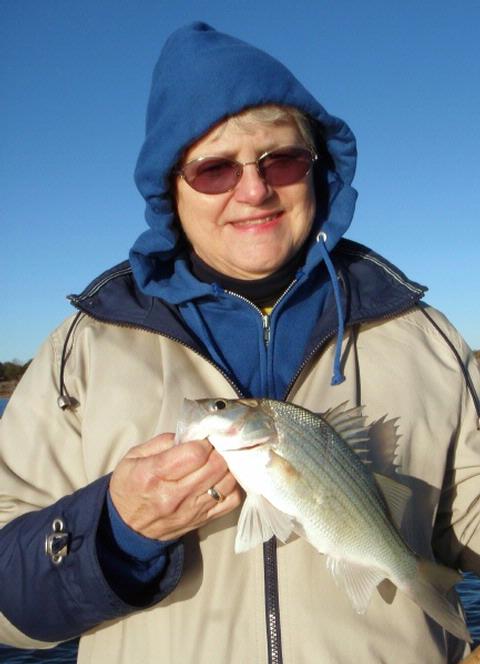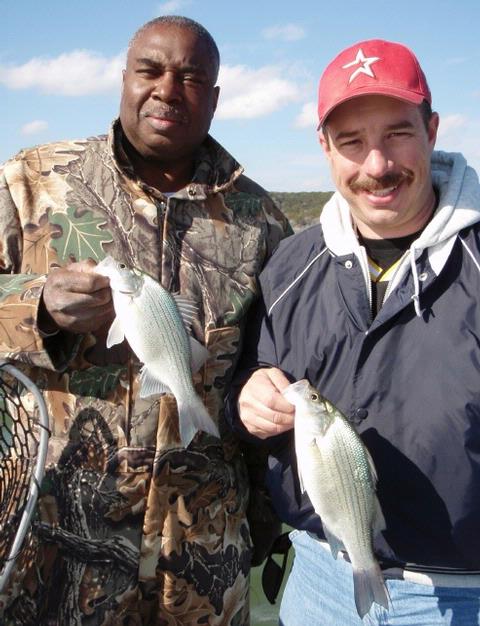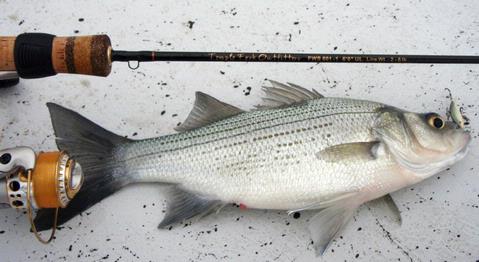Fished a half day uncle/nephew trip with Justin W. of Colorado and his nephew, Jake W., of Salado. Justin is a commercial pilot and flies C-140’s in the Air Guard. Jake is a 4th Grader at Salado ISD who is, for a short time longer, without his dad, Jason, who is currently deployed to Iraq as a reservist in Army Aviation.
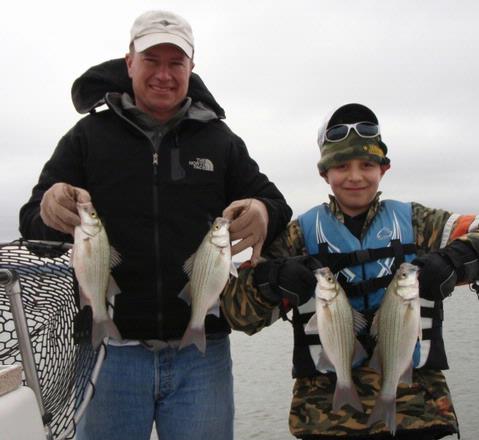
Justin (L) and Jake (R) with four fistfuls of vertically jigged white bass taken out of 48 degree water on what was the best trip I’ve had to date since the flooding.
Start Time: 7:15a
End Time: 12:20p
Air Temp: 47F at trip’s start
Water Surface Temp: 48.9F
Wind: Winds were moderate from due S. at ~12-14 the entire trip
Skies: Skies were leaden grey and heavy the entire trip.
After Wednesday’s failed experiment on Belton, I decided we’d put this trip together on Stillhouse, and that turned out to be a good decision. The water level on Stillhouse is now at about 3 feet above full pool and the water has cleared up pretty well. I did note that any significant wind now immediately stirs silt up on the impacted shoreline leading to localized stained water, but, the lake as a whole is in pretty good shape once again.
We did some searching with sonar around (obscured) sunrise, and found some bait and some fish tight to bottom in 25-27 feet of water near Area 314. I chose TNT180’s in 3/8 oz. to start the fellows off with — a bit heavier than I really like for cold water, but, it allowed them to get the feel of the jigging rhythm and know where their baits were in relation to bottom at all times. Once we got situated and they got the hang of jigging, things began to happen for us. The first fish over the side was a small crappie. No sooner had we caught that fish, than 4 gulls came and began to patrol and act hesistant to leave an area within 200 yards of us. I felt as though fish were in there, but just not cranked up yet, so, despite the slow action, we hung with it.
By around 8:30, we still had birds present, but had only put 2 more fish (both white bass) in the boat. It was getting steadily brighter, and the wind was very steady. I decided to move us in a bit closer to shore where the effects of this wind would be impacting on the bottom by moving silt and, as a result, the rest of the food chain. As I moved in on Area 595 (BA: 1O, 4HG, 6L, 3T) the sonar began to reveal fish laying belly to the bottom here from 25 feet right up to 16 feet. I oriented the nose of the boat into the wind, put a buoy out well upwind to orient onto, and we went to work on these fish for about 2 hours straight. The action never got frenzied (remember, the temperature is still in the 40’s), but it was steady, the bites were solid, and the fish cooperated for a much longer spell than they typically do in cold water. Eventually, around 10:40, things ground to a halt. We’d put 41 fish in the boat by this time.
I was encouraged that we’d found fish in water as shallow as 16 feet, and so, in order to cover a lot of water quickly looking for a few remaining active fish, we set up with a slow, flatline troll in 4 different areas (Areas 116, 352, the 114-336-319-343 circuit, and Area 999), but that failed to produce even a single fish. By around noon, we knew we’d seen the best of it and decided to hit just one last area on our way back the the ramp.
We stopped and looked over Area 145/148 with sonar and found suspended bait and a few gamefish mixed in at around 20 feet over a 35 foot bottom. I’d hoped to give Justin a shot at “sniping” a fish during this trip, as he’s done a bit of ice fishing, and this technique is much like that method of angling. We spotted a lone fish on sonar, and so I demonstrated the “sniping” technique to Justin and landed the fish I had targeted. Justin was now pumped to get one of his own! As we hovered in place, a single, suspended white bass appeared on sonar and, despite the wind, we were able to hang with it and keep it on sonar as Justin got his lure situated correctly. We watched together as the fish’s sonar signal merged with the lure’s sonar signal and Justin’s rod tip went down. He responded with a good hookset and we landed that one last fish via “sniping” — a pretty cool, high-tech end to a very good cold-weather season trip.
We ended the day sharing an outdoor lunch at one of the park sites on the shores of Stillhouse and then parted ways. For our efforts today, we boated a total of 43 fish. This was the best trip I’ve had up to this point since January 27th, which was before the flooding rains of 29-30 January.
I was really impressed with 9 year old Jake. Winter fishing in such cold water doesn’t offer a great variety of tactics. He stayed with the vertical jigging regimen for the vast majority of the trip and did much better than most kids his age would have under such conditions despite cool, damp winds and red, cold hands. He was a trooper!
TALLY = 43 Fish, all caught and released
***For a complete listing of gear and lures used, please go to the “About” tab, and click on the “About Your Guide” page on the drop-down menu.


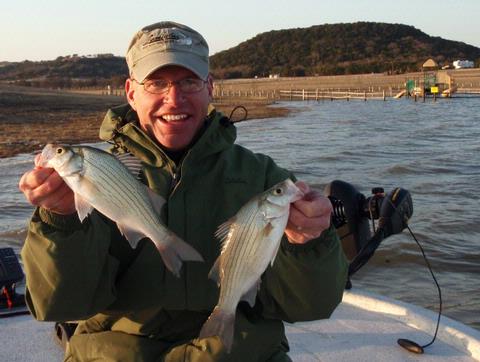
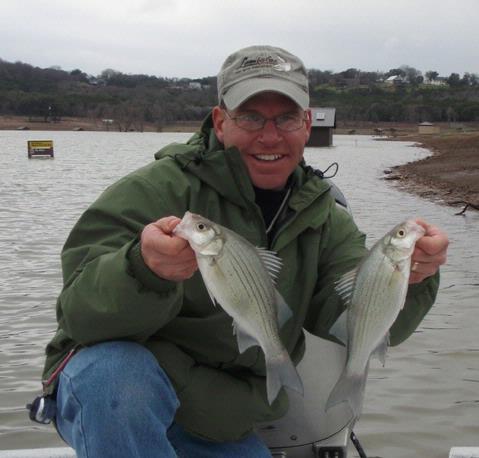
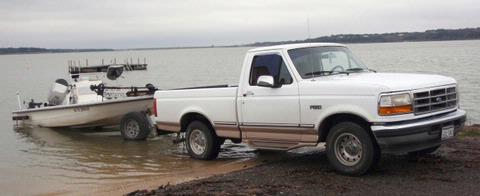
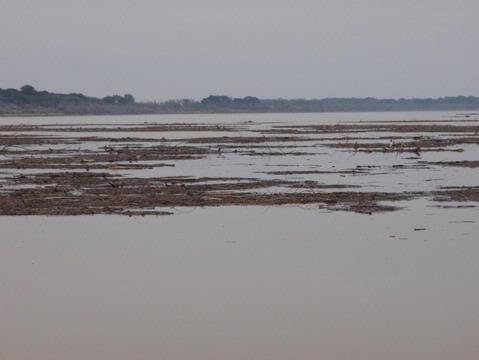
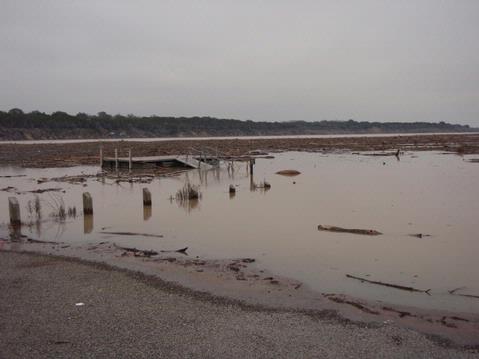
.jpg)
